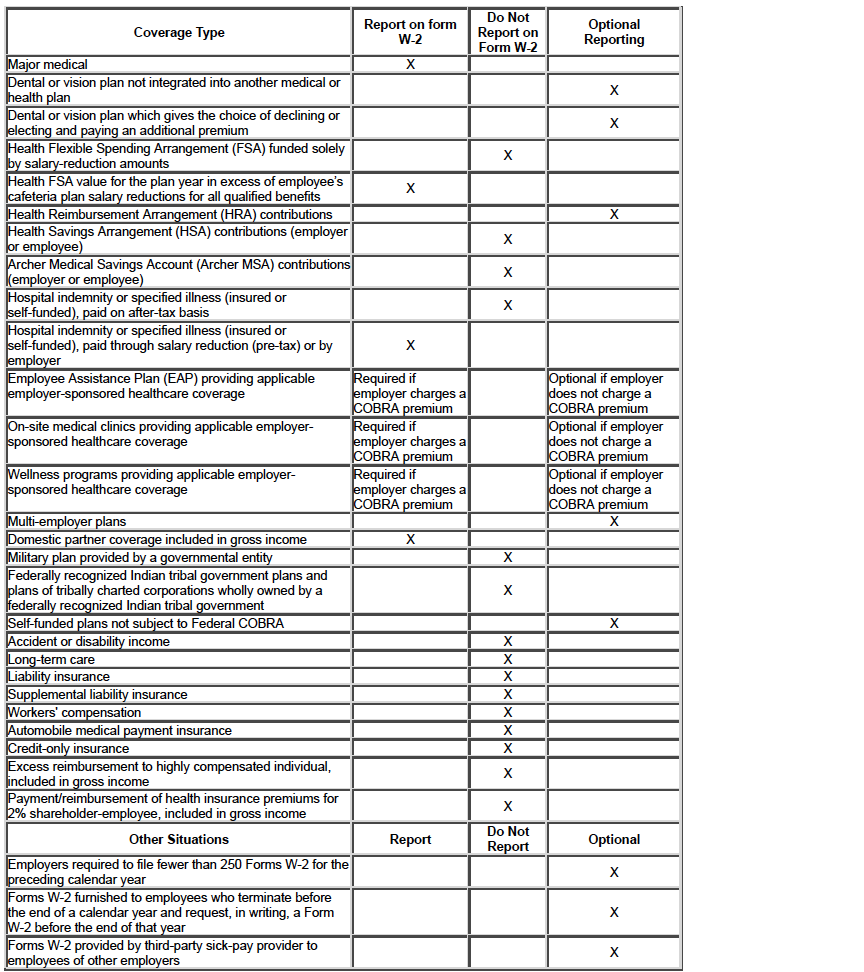The Affordable Care Act created a new health coverage reporting requirement intended to provide employees useful and comparable consumer information about the cost of their health care coverage. Form W-2 reporting is for informational purposes only and does not change the taxability of the health coverage provided.
Employers are required to calculate and report the aggregate cost of employer-sponsored health coverage in Box 12, Code DD on employees' Form W-2. The reporting requirement first applies to the Form W-2 for 2012 that is generally provided to employees in January 2013. Employers should now be thinking about if the reporting requirement applies and if it does, how to properly report the cost of health coverage.
Which Employers Must Report
Employers that provide "applicable employer-sponsored coverage" under a group health plan are subject to the reporting requirement. Health care reform originally required all employers to report the value of coverage; however, the IRS modified the reporting obligations in a Notice issued earlier this year. Presently, the Form W-2 reporting obligation applies to employers (businesses, tax-exempt organizations, and federal, state and local government entities (except with respect to plans maintained primarily for members of the military and their families)) who issue 250 or more Forms W-2 for the prior calendar year. That means an employer who issued 250 or more Forms W-2 with respect to 2011 must report for the 2012 Form W-2.
Employers filing fewer than 250 Forms W-2 for the previous calendar year may, but are not required to, report the cost of coverage on the 2012 Form W-2. Multi-employer plans are also not required to report. The IRS has stated that this relief from the reporting requirements will apply until the IRS issues guidance specifically making the reporting applicable.
What Coverage Must Be Reported
An employer will have to determine the coverage that must be reported on the Form W-2 if the employer is required to report or voluntarily decides to report. The IRS has explained that reporting applies to "applicable employer-sponsored coverage." This is generally coverage under a group health plan that an employer makes available to an employee that is not taxable to the employee.
Medical plan coverage is included in the value of coverage that must be reported. Free-standing dental and visions plans are not subject to the reporting requirement if the plans are excepted from HIPAA, are not integrated into another group health plan or give participants the choice of declining the coverage or electing it and paying an additional premium. Employers do not have to report the cost of an EAP, wellness program or on-site medical clinic if the employer would not charge a premium for the coverage to COBRA participants. Health reimbursement arrangements and indemnity insurance paid with after-tax dollars does not have to be reported. Health flexible spending accounts funded with employee contributions, only, are not reported, but a reporting obligation may arise if an employer contributes to the FSA or otherwise provides flex-dollars through a Code section 125 plan. Self-insured plans of employers not subject to COBRA or similar continuation requirements (such as church plans) are not reported. See below for a summary of reporting requirements by type of coverage.
Determining the Value to Report
Employers should be quantifying the cost of health coverage that will be reported on employees' Form W-2.
The aggregate reportable cost includes both the employer and employee-paid portion of coverage, regardless of whether the employee paid for that coverage through pre-tax or after-tax contributions. It includes the cost expended for coverage of the employee, as well as for any person covered under the plan because of a relationship to the employee (i.e., Employee coverage, as well as Dependent/Family coverage).
Aggregate reportable cost may be calculated in one of a few different ways. Employers will likely report using a COBRA applicable premium method. Alternatively, (1) an employer that is determining the cost of coverage in an insured plan may calculate the reportable cost using the premium charged method; and (2) an employer that subsidizes the cost of coverage or that determines the cost of coverage for a year by applying the cost of coverage in a prior year may calculate the reportable cost using a modified COBRA premium method. There are special rules for employers that charge employees a composite rate for coverage (i.e., the same premium for different types of coverage).
Under the COBRA method, the employer reports an amount equal to the COBRA applicable premium for the coverage period. This is the cost of coverage for non-COBRA beneficiaries (including both employer and employee contributions), but excluding any administrative fee added on top of the COBRA-calculated rate.
Under the premium charged method, an employer reports the cost of insured coverage using the premium charged by the insurer for the employee’s coverage.
To use the modified COBRA premium method, the employer must subsidize the cost of COBRA coverage or charge COBRA beneficiaries a prior year’s rate. If this applies, the employer may determine the reportable cost for a period based upon a reasonable good faith estimate of the COBRA premium for the period.
If an employer charges a composite rate (charges for a single coverage class under the plan, or charges the same premium for all coverages), the employer may calculate and use the same reportable cost for the single class of coverage or for the different types of coverage, provided the method is applied consistently.
Penalties
Penalties for not reporting may be up to $50 per filing, with a maximum of $250,000 per year. Penalties may be reduced for prompt correction.
Assistance with Form W-2 Reporting
BAS' systems are equipped to provide the required information for compliance with the Form W-2 reporting requirements. BAS can provide self-service access to a report of all the health coverage data elements necessary to provide a payroll system with the required reporting values. Please contact Sales@BASusa.com for more information about the BAS Form W-2 Reporting Service.
Form W-2 Reporting of Employer-Sponsored Health Coverage










